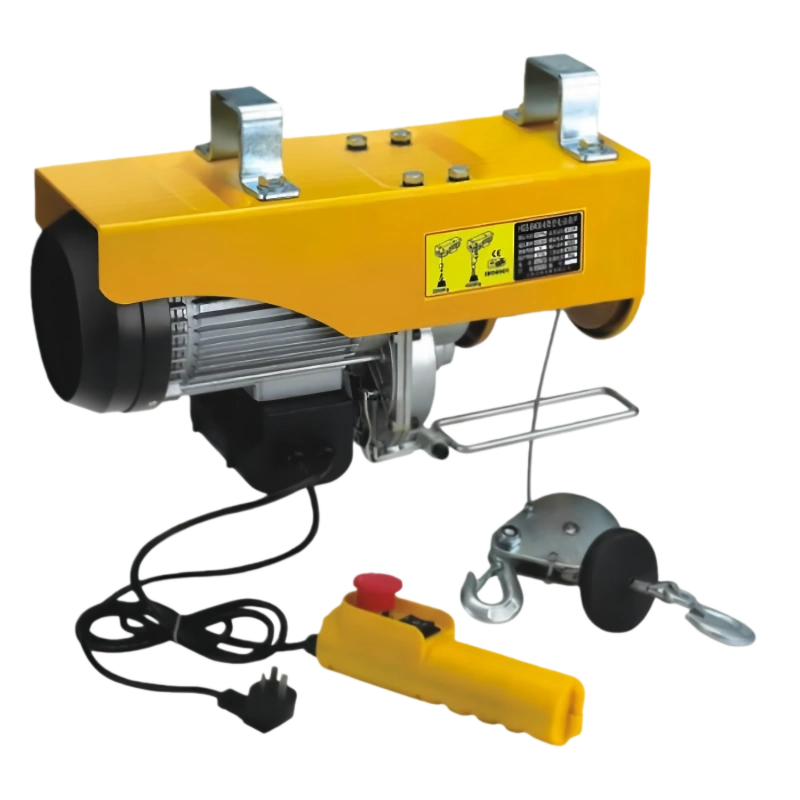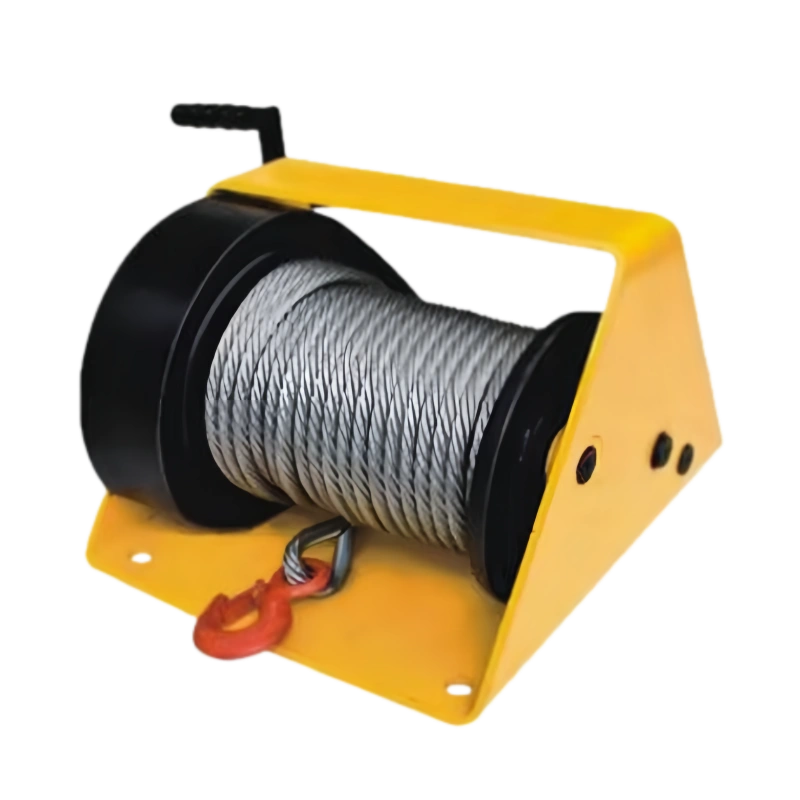ELECTRIC MINI HOIST SPECIFICATIONS
| Model | CQ-PA200A | CQ-PA250A | CQ-PA300A | CQ-PA400A | CQ-PA500A | CQ-PA600A | CQ-PA700A | CQ-PA800A | CQ-PA1000A | CQ-PA1200A | |||||||||||
| Methodofuse | Single hook |
Double hook |
Single hook |
Double hook |
Single hook |
Double hook |
Single hook |
Double hook |
Single hook |
Double hook |
Single hook |
Double hook |
Single hook |
Double hook |
Single hook |
Double hook |
Single hook |
Double hook |
|||
| Ratedvolt(V) | AC220/230/240 50/60Hz | ||||||||||||||||||||
| Inputpower(W) | 480 | 510 | 600 | 950 | 1020 | 1200 | 1250 | 1300 | 1600 | 1800 | |||||||||||
| Ratedcapacity(kg) | 100 | 200 | 125 | 250 | 150 | 300 | 200 | 400 | 250 | 500 | 300 | 600 | 350 | 700 | 400 | 800 | 500 | 1000 | 600 | 1200 | |
| Liftingspeed(M/min) | 10 | 5 | 10 | 5 | 10 | 5 | 10 | 5 | 10 | 5 | 10 | 5 | 8 | 4 | 8 | 4 | 8 | 4 | 8 | 4 | |
| Liftingheight(m) | 12 | 6 | 12 | 6 | 12 | 6 | 12 | 6 | 12 | 6 | 12 | 6 | 12 | 6 | 12 | 6 | 12 | 6 | 12 | 6 | |
| Qty./CTNpcs) | 2 | 1 | |||||||||||||||||||
| Packingsize(mm) | 470×370×160 | 520×420×170 | 560×250×350 | ||||||||||||||||||
| G.w/N.w(kg) | 24/22 | 25/23 | 35/33 | 39/37 | 33/32 | ||||||||||||||||
MINI TYPE ELECTRIC HOIST FEATURES
-
Custom Voltage Options: Choose from single-phase or three-phase, 110V to 575V.
-
Customizable Chain Materials: Select from T80 or T100, with options for galvanized, nickel-plated, or blackened finishes.
-
Safety Features: Emergency stop switch, reinforced breaking switch, limit devices, and thermal protection.
-
Function Customization: Options include explosion-proof, dust-proof, rain-proof, frequency conversion, and two-speed settings.
-
Convenient Wireless Control: Optional wireless remote control for easy operation.
-
Certifications: CE, EMC, LVD, and RoHS certified for high-quality performance and safety compliance.
INSTRUCTIONS & CAUTIONS
Check Load Capacity Before Use
Before operating the mini electric hoist, always verify that the load does not exceed the hoist’s rated capacity. Overloading can cause serious damage to the equipment and create safety hazards. Always refer to the product specifications for the correct load limits. If in doubt, consult the user manual for further guidance on the appropriate capacity for safe use.
Ensure Proper Installation
For safe and efficient operation, it’s essential that the mini electric hoist is installed correctly. Make sure the hoist is securely mounted and aligned with the load. The wire rope should be positioned properly, and the hook must be correctly attached to avoid slippage. Double-check all connections and ensure the hoist is level before starting to operate. Follow the manufacturer’s installation guidelines to ensure everything is set up safely.
Perform Regular Maintenance and Inspections
Maintaining your mini electric hoist is key to its longevity and performance. Regularly inspect the hoist for signs of wear, especially the wire rope, and replace any worn or damaged parts immediately. Lubricate the moving components, clean the hoist after use, and check that all safety features are functioning properly. Regular maintenance helps prevent unexpected breakdowns and ensures smooth, safe operation.
Use Built-In Safety Features Correctly
The mini electric hoist is equipped with several safety features, including an emergency stop switch, thermal protection, and limit switches. Always use these safety functions during operation to protect both the hoist and the operator. Ensure that limit switches are properly set to avoid overloading or overtravel. If your hoist includes a wireless remote control, use it within the recommended range for safe operation.
OUR ADVANTAGES
Tailored Solutions to Meet Your Unique Needs
At Powerful Machinery, we understand that every business has unique requirements. That’s why we offer fully customizable lifting equipment. Whether it's voltage options, materials, or specialized features, we adapt our products to suit your specific needs. Our custom-engineered solutions ensure your equipment works exactly as required, boosting your efficiency and productivity.
Uncompromising Quality and Safety Standards
We prioritize quality and safety in everything we do. Our products undergo strict quality checks and are built to meet top industry certifications like CE, EMC, and RoHS. This means you get reliable and safe lifting equipment that you can count on, no matter how tough the job. When you choose us, you're choosing equipment that performs consistently, day in and day out.
Fast and Reliable Logistics to Keep You on Track
We know that timing is critical in business. That’s why Powerful Machinery offers efficient logistics and on-time delivery for all orders. Whether you need bulk orders or small, time-sensitive shipments, our logistics team ensures your equipment arrives when you need it. We’re committed to getting you the right products, at the right time, to keep your projects moving forward.
Dedicated After-Sales Support for Long-Term Satisfaction
Our relationship with you doesn’t end once your order is delivered. We provide exceptional after-sales support to help you get the most out of your equipment. Whether you need troubleshooting, maintenance advice, or general inquiries, our expert customer service team is here to help. With Powerful Machinery, you get peace of mind knowing that we’re always just a call away.
FAQ
What is an electric hoist?
An electric hoist is a lifting device powered by electricity. It uses a motor to either wind a chain or wire rope, allowing you to lift and lower heavy loads efficiently. Electric hoists are commonly used in warehouses, construction sites, and factories where heavy lifting is required. They provide reliable and fast lifting compared to manual alternatives, making tasks safer and more productive.
How to fix an oil leak in an electric hoist?
-
Turn off the power
Ensure the hoist is completely powered down before starting any repairs to avoid accidents. -
Drain the oil
Carefully drain the oil from the hoist to prevent contamination and ensure a clean workspace. -
Locate the source of the leak
The most common areas for oil leaks are seals or gaskets. Inspect these parts for damage or wear. -
Replace damaged parts
Replace any seals or gaskets that are damaged or worn out to prevent further leakage. -
Clean the affected area
Thoroughly clean the area around the leak to remove any old oil, dirt, or debris. -
Refill with the correct oil
Refill the hoist with the appropriate oil type recommended by the manufacturer. -
Regular maintenance and inspections
Conduct regular maintenance and inspections to prevent future leaks and ensure your hoist operates smoothly.
How does an electric hoist work?
An electric hoist uses a motor to drive a gear mechanism, which then moves either a chain or wire rope. This allows the hoist to lift or lower loads. Operators control the hoist via a switch or remote control, adjusting the lifting speed and direction. Safety features such as limit switches and thermal protection prevent overloads and ensure safe operation, making electric hoists ideal for industrial environments.
How to install an electric hoist?
-
Secure the hoist to a strong overhead structure
Attach the hoist to a stable and sturdy overhead beam or support using the appropriate mounting hardware. -
Ensure the hoist is level and properly aligned
Make sure the hoist is positioned level and aligned correctly to prevent strain and ensure smooth lifting operation. -
Connect the hoist to the electrical power supply
Wire the hoist to the power supply, following proper electrical guidelines. Make sure the hoist is grounded for safety. -
Perform a test run
Run a test to verify that the hoist lifts and lowers properly, ensuring it functions correctly and safely. -
Check for smooth operation and safety
After the test, ensure the hoist operates without any issues and is safe for use in your lifting tasks.
Electric hoist vs manual hoist: What’s the difference?
-
Power Source
-
Electric Hoist: Powered by electricity, providing fast, efficient lifting for heavy loads.
-
Manual Hoist: Operated by physical labor, typically using a hand chain or lever, making it slower and more labor-intensive.
-
-
Speed & Efficiency
-
Electric Hoist: Ideal for high-capacity, repetitive lifting tasks in industrial environments, saving time and effort.
-
Manual Hoist: Better suited for smaller, less frequent lifting jobs, but not as efficient as electric hoists.
-
-
Portability & Affordability
-
Electric Hoist: Generally more expensive and requires a power source, but provides higher lifting capacity and speed.
-
Manual Hoist: More affordable, portable, and simpler to use, but may not handle larger loads or tasks as quickly.
-
Air Hoist vs Electric Hoist: Which is Better?
-
Power Source
-
Air Hoist: Powered by compressed air, making it suitable for hazardous environments where electricity is not safe (e.g., explosive areas).
-
Electric Hoist: Requires an electrical power source, offering higher efficiency and capacity for industrial settings.
-
-
Safety & Environment
-
Air Hoist: Safer in environments where electricity could pose a risk, as it does not require electrical connections.
-
Electric Hoist: Best for high-volume industrial use, but should be used in environments where electrical hazards are controlled.
-
-
Lifting Capacity & Speed
-
Air Hoist: Ideal for lifting in environments where air power is available and when electricity isn’t feasible.
-
Electric Hoist: Provides faster lifting speeds, more control, and higher lifting capacities, making it the preferred choice for high-demand tasks.
-
Electric hoist inspection checklist
An electric hoist inspection checklist should include:
-
Checking the motor, gearbox, and electrical components for wear.
-
Inspecting the chain or rope for any damage or signs of wear.
-
Testing the limit switches and emergency stop function.
-
Checking hooks and lifting mechanisms for stress or cracks.
-
Verifying proper lubrication and cleaning of moving parts.
-
Ensuring the hoist operates within its rated load capacity.
How often should an electric hoist be serviced?
To keep your electric hoist in top condition, service it regularly. Perform a basic inspection before each use. A full service—including lubrication and checking for wear—should be done every 6 to 12 months, depending on usage. Regular maintenance will prevent costly repairs and keep the hoist functioning efficiently, reducing downtime and increasing safety on the job.




